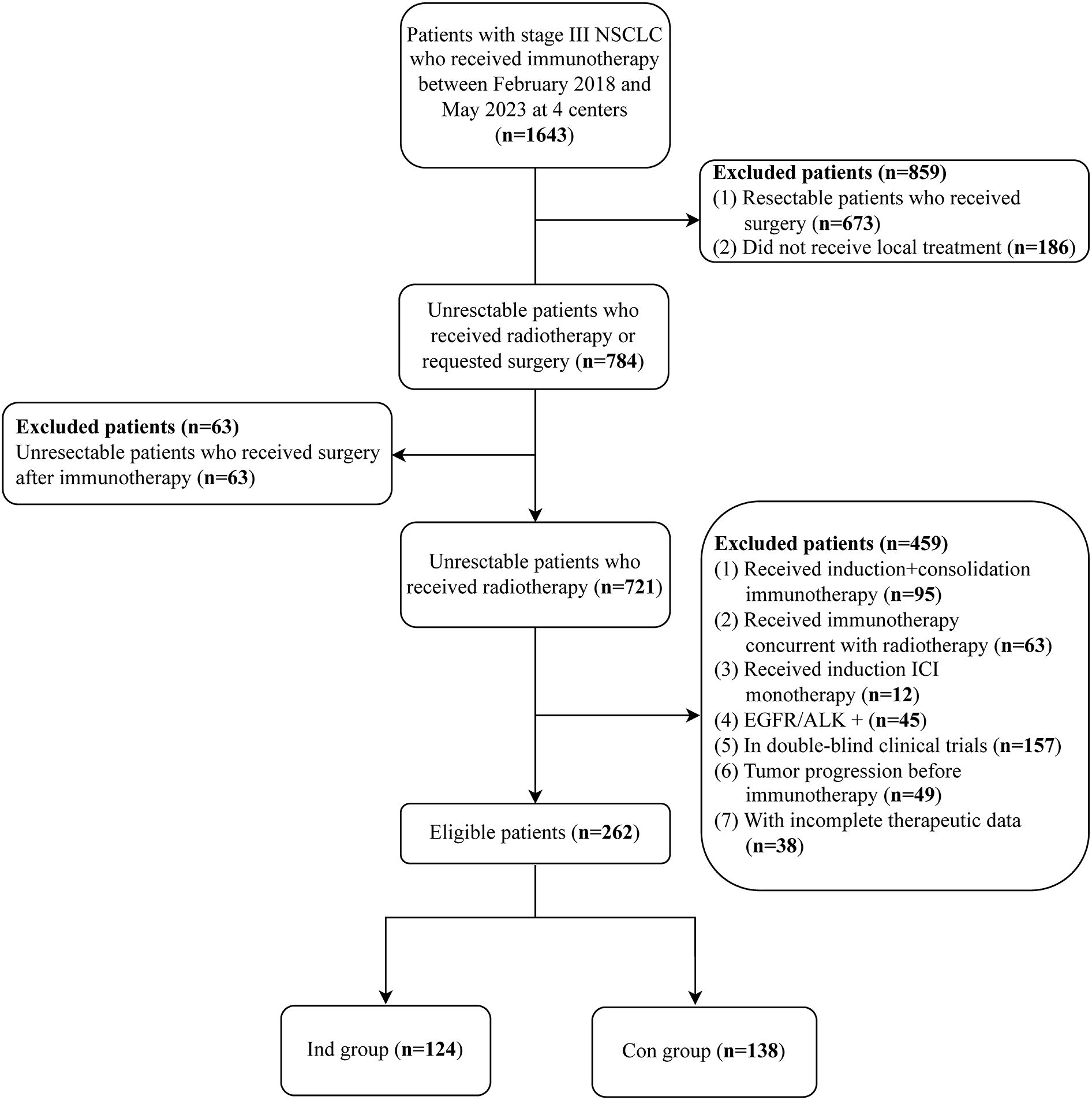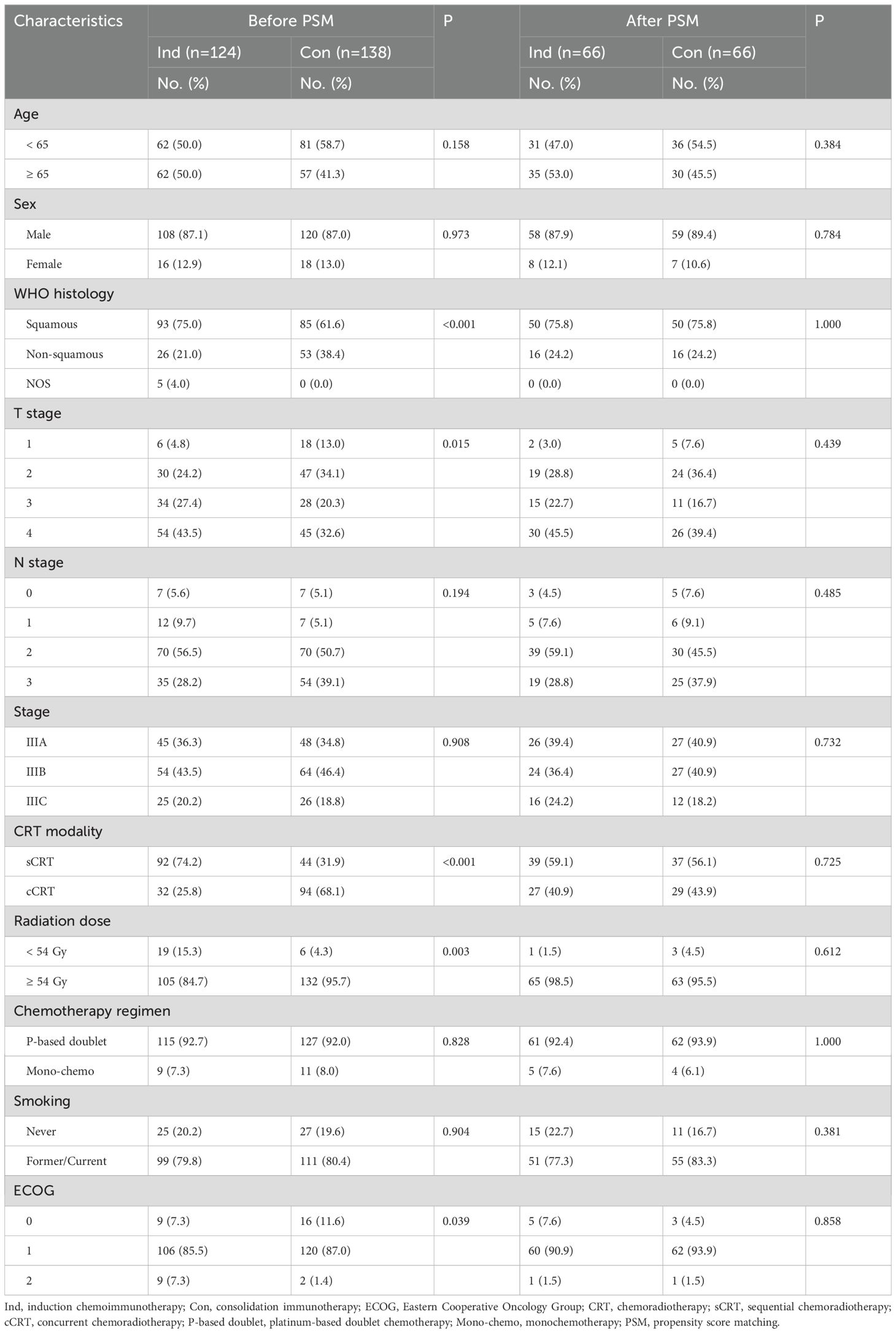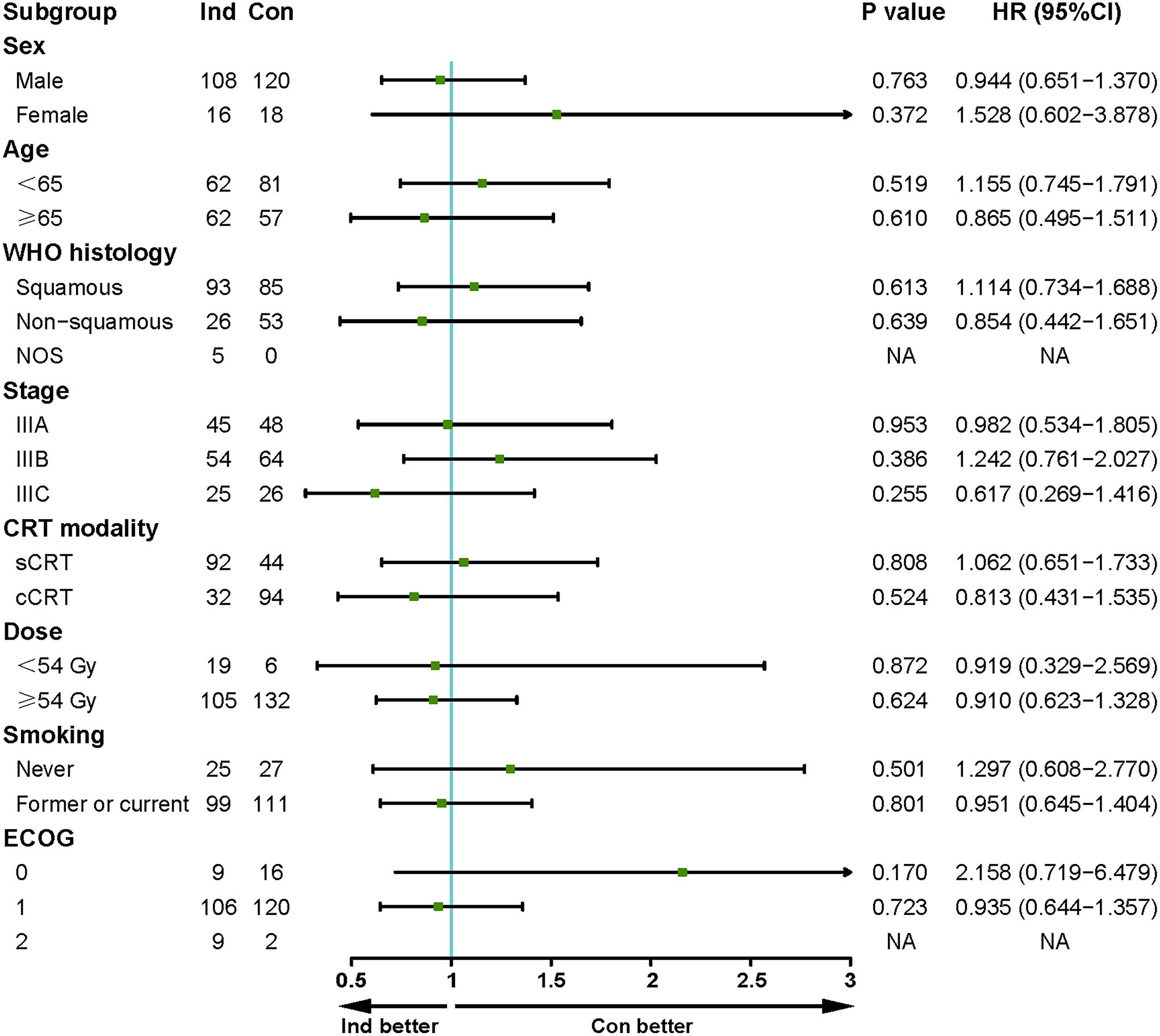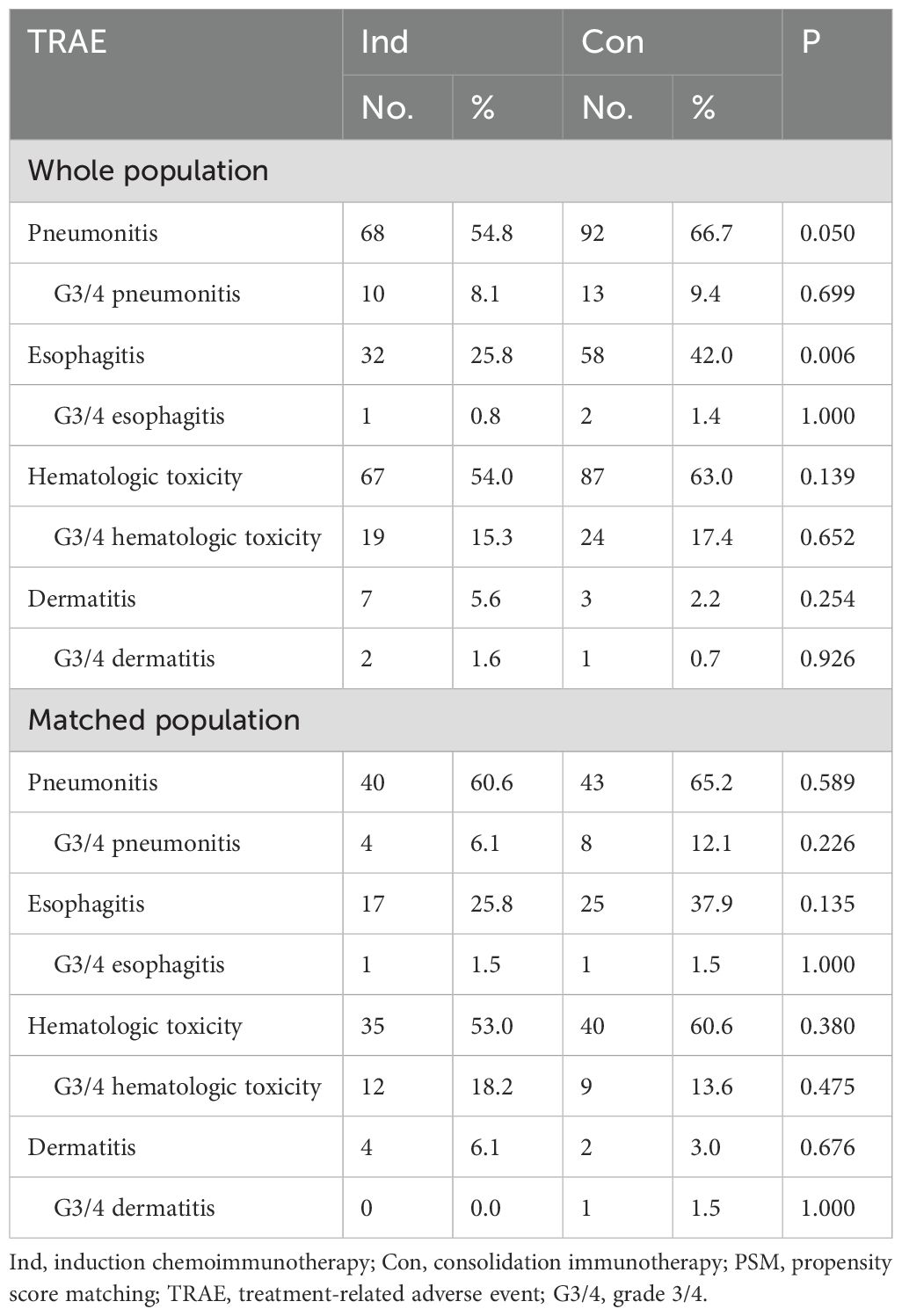- 1Department of Radiation Oncology, Tianjin Medical University Cancer Institute & Hospital, National Clinical Research Center for Cancer, Tianjin’s Clinical Research Center for Cancer, Key Laboratory of Cancer Immunology and Biotherapy, Tianjin, China
- 2Department of Radiation Oncology, Beijing Tuberculosis and Thoracic Tumor Research Institute/Beijing Chest Hospital, Cancer Research Center, Capital Medical University, Beijing, China
- 3Department of Radiation Oncology, National Cancer Center/National Clinical Research Center for Cancer/Cancer Hospital, Chinese Academy of Medical Sciences and Peking Union Medical College, Beijing, China
- 4Department of Radiotherapy, The Fourth Hospital of Hebei Medical University, Hebei Clinical Research Center for Radiation Oncology, Shijiazhuang, China
Background: Consolidation immunotherapy after chemoradiotherapy (CRT) is the standard of care for unresectable stage III non-small cell lung cancer (NSCLC). However, the role of upfront chemoimmunotherapy before CRT remains unclear. This study aims to investigate the value of induction chemoimmunotherapy before CRT in unresectable stage III NSCLC.
Methods: Unresectable stage III NSCLC patients who received induction chemoimmunotherapy before CRT or consolidation immunotherapy after CRT from four centers were retrospectively enrolled. The Kaplan-Meier method was used to estimate progression-free survival (PFS) and overall survival (OS), and one-to-one propensity score matching (PSM) was used to further minimize confounding.
Results: A total of 262 patients were enrolled, with 124 (47.3%) receiving induction chemoimmunotherapy (Ind group) and 138 (52.7%) receiving consolidation immunotherapy (Con group). Further 1:1 PSM analysis showed that induction chemoimmunotherapy achieved comparable outcomes to consolidation immunotherapy (2-year PFS: 56.0% vs. 45.6%, P=0.327; 2-year OS: 81.0% vs. 79.2%, P=0.960) with fewer cycles of immunotherapy (median 4 vs. 10 cycles, P<0.001). The incidence of treatment-related adverse events was similar (P>0.05). Exploratory analysis found that patients with < 4 cycles of induction immunotherapy had similar PFS (median NR vs. 30.1 months, 2-year PFS 50.8% vs. 54.4%, P=0.932) but prolonged OS (median NR vs. 46.0 months, 2-year OS 89.0% vs. 75.5%, P=0.112) compared to those with ≥ 4 cycles of induction immunotherapy.
Conclusion: Upfront chemoimmunotherapy before CRT appears to be feasible and safe, and may achieve non-inferior outcomes to consolidation immunotherapy with fewer cycles of immunotherapy.
1 Introduction
The treatment paradigm for stage III non-small cell lung cancer (NSCLC) has been revolutionized by the advent of immunotherapy. For patients with unresectable stage III NSCLC, the current standard of care is consolidation immunotherapy following concurrent chemoradiotherapy (cCRT), known as the PACIFIC regimen (1, 2), although the optimal combination strategy of immunotherapy and chemoradiotherapy (CRT) remains unclear. The 5-year progression-free survival (PFS) rate in the PACIFIC trial was only 33.1%, indicating that nearly 70% of patients with stage III NSCLC had uncontrolled disease (2). Besides, not only is the proportion of patients receiving consolidation immunotherapy low, but the proportion of patients receiving cCRT is also low for various reasons, such as excessive target volume or poor tolerability (3, 4). Although the addition of consolidation immunotherapy after sequential CRT (sCRT) may benefit patients with stage III NSCLC, it is not as effective as consolidation immunotherapy after cCRT (5, 6). Therefore, optimizing the combination of CRT and immunotherapy is urgently needed. In the context of surgery, immunotherapy, whether used preoperatively or postoperatively, confers a survival benefit in patients with resectable NSCLC (7–9), raising the question of whether upfront chemoimmunotherapy prior to CRT could benefit patients or achieve non-inferior outcomes to consolidation immunotherapy in patients with unresectable stage III NSCLC. However, apart from a few single-arm clinical trials or retrospective studies that have demonstrated the safety and efficacy of upfront immunotherapy before CRT based on the use of consolidation immunotherapy, there are currently no studies to answer this question (10–12). Therefore, we conducted this multicenter retrospective study to investigate the role of upfront chemoimmunotherapy before CRT in unresectable stage III NSCLC through real-world data.
2 Materials and methods
2.1 Patient selection
Patients with unresectable stage III NSCLC who received induction chemoimmunotherapy before CRT without consolidation immunotherapy, or consolidation immunotherapy after CRT at Tianjin Medical University Cancer Institute & Hospital, National Cancer Center/National Clinical Research Center for Cancer/Cancer Hospital, Beijing Chest Hospital, and the Fourth Hospital of Hebei Medical University between February 2018 and May 2023 were enrolled. The inclusion criteria for this study consisted of the following: 1) patients aged 18 years or older; and 2) individuals with histopathologically confirmed stage III NSCLC, and 3) received induction chemoimmunotherapy before thoracic radiation or consolidation immunotherapy after thoracic radiation. The exclusion criteria encompassed: 1) patients exhibiting an anaplastic lymphoma kinase (ALK) rearrangement or an epidermal growth factor receptor (EGFR) mutation; 2) those with a history of any prior cancer-specific treatment; 3) patients who experienced tumor progression before immunotherapy; 4) individuals who received induction immune checkpoint inhibitor (ICI) monotherapy; and 5) patients who received immunotherapy before and after radiotherapy, or concurrently with radiotherapy, or as part of a clinical trial. The medical records were utilized to extract baseline characteristics and therapeutic information pertinent to the patients. The World Health Organization (WHO) criteria (13) and the 8th edition classification by the International Association for the Study of Lung Cancer (14) were employed to determine the histological type and stage of each NSCLC case.
According to the sequencing of immunotherapy and radiotherapy, patients were divided into the induction chemoimmunotherapy (Ind), and consolidation immunotherapy (Con) groups, respectively. This study conformed to the provisions of the Declaration of Helsinki (as revised in 2013) and was approved by the institutional medical ethics committee (No. bc2022212).
2.2 Drug treatment
The treatment scheme for each patient was decided by a multidisciplinary team including radiation oncologists and surgeons. Induction chemoimmunotherapy is given mainly to reduce the target volume that is too large or too extensive to meet the normal tissue constraints for definitive CRT, or to downstage as far as possible, thereby increasing the possibility of radical resection. The PD-1/PD-L1 inhibitors used included Atezolizumab, Camrelizumab, Durvalumab, Nivolumab, Pembrolizumab, Sintilimab, Sugemalimab, Tislelizumab and Toripalimab. These nine kinds of ICIs have been approved for the treatment of locally advanced or metastatic NSCLC based on the promising outcomes in NSCLC patients (1, 5, 7, 11, 15–19). Different chemotherapy regimens were administrated to each patient based on various factors, including the histological type of the tumor and the individual clinical condition of the patient.
2.3 Study outcomes
Clinical outcomes were evaluated, including progression-free survival (PFS) and overall survival (OS). PFS was calculated from the initiation of treatment until the first recorded instance of disease progression, the date of death without progression, or the last follow-up. OS was estimated from the start of treatment until death or the last follow-up. Patients underwent follow-up visits every three months for the first two years and thereafter every six months, encompassing clinical evaluations, computed tomography (CT) or positron emission tomography (PET) scans, along with additional investigations when clinically warranted. Treatment-related adverse events (TRAEs) for individual patients were evaluated using the Common Terminology Criteria for Adverse Events (CTCAE) version 5.0. Objective response rates (ORRs) and disease control rates (DCRs) were assessed following induction immunotherapy, where ORR was defined as the sum of partial response (PR) and complete response (CR), and DCR was defined as the sum of PR, CR, and stable disease (SD) in accordance with the Response Evaluation Criteria in Solid Tumors (RECIST) v1.1.
2.4 Statistical analysis
Demographic and clinical characteristics of patients between treatment arms were compared using the Wilcoxon ranked sum test for continuous variables and the Chi-square test or Fisher’s exact test for categorical variables. Survival analyses were performed using the Kaplan-Meier method to estimate PFS and OS, which were then compared using the log-rank test. When the univariate analysis yielded a P value of ≤ 0.1, the variable was incorporated into the multivariate Cox regression analysis. Subgroup analysis (age [< 65 years or ≥ 65 years], sex [male or female], WHO histology type [squamous, non-squamous, or not otherwise specified], cancer stage [IIIA, IIIB, or IIIC], chemoradiotherapy modality [sequential or concurrent], radiotherapy dose [< 54 Gy or ≥ 54 Gy], smoking history [never, former or current], ECOG performance status [0, 1 or 2]) for PFS was performed to assess the consistency of treatment effects in patient subgroups. Subgroup analysis used an unstratified Cox proportional hazards model with treatment as a covariate. To minimize confounding, one-to-one propensity score matching (PSM) was performed with a caliper setting of 0.02, adjusting for various baseline characteristics. Statistical significance was set at a P value of less than 0.05. All statistical calculations were performed using SPSS software, version 25 (IBM Corporation, Armonk, NY, USA).
3 Results
3.1 Baseline characteristics
A total of 262 consecutive eligible patients were enrolled in this study. Among them, 124 (47.3%) received induction chemoimmunotherapy, and 138 (52.7%) received consolidation immunotherapy (Figure 1). The median age was 64 years (range 31-79). Patients in the Ind group had more advanced T stage and poorer ECOG performance status compared to those in the Con group. The detailed clinical characteristics of the patients are shown in Table 1.
3.2 Treatment
The ICI agents used included Atezolizumab (0.7%, n=2), Camrelizumab (11.1%, n=29), Durvalumab (30.9%, n=81), Nivolumab (1.9%, n=5), Pembrolizumab (11.8%, n=31), Sintilimab (24.0%, n=63), Sugemalimab (0.4%, n=1), Tislelizumab (13.7%, n=36), and Toripalimab (5.3%, n=14). Detailed information on the ICI agents in each group is shown in Supplementary Table S1. All patients in the Ind group received induction PD-1 inhibitor plus chemotherapy, with a median of 4 cycles of induction immunotherapy (range 1-12). Reasons for patients receiving chemoimmunotherapy before CRT included high tumor burden (70.2%, n=87), ineligibility for cCRT (16.1%, n=20), ineligibility for surgery after preoperative neoadjuvant chemoimmunotherapy (8.9%, n=11), and patient preference (4.8%, n=6). Patients in the Con group received a median of 10 cycles of consolidation immunotherapy (range 1-63). 39.1% (n=54) of patients in the Con group received a PD-1 inhibitor, while 60.9% (n=84) received a PD-L1 inhibitor. More patients in the Con group received cCRT than in the Con group (68.1% vs. 25.8%, P<0.001). For patients receiving sCRT, the cycle numbers of chemotherapy were similar in both groups, with a median of 4 cycles in each (P=0.777).
3.3 Efficacy
In the entire cohort, median follow-up from the initiation of treatment was 24.9 months (range 5.1-67.6 months). Median PFS and OS were 25.8 and not reached (NR), respectively. During the investigation, 111 patients developed progressive disease (PD), including 52 (41.9%) and 59 (42.8%) cases in the two groups, respectively. Five (4.0%) patients in the Ind group developed PD during induction chemoimmunotherapy, with 4 patients developing local progression and 1 patient developing systemic progression. Sixty-three patients died at the time of analysis, including 29 (23.4%) and 34 (24.6%) cases in the two groups, respectively. The majority of patients (77.8%) died of lung cancer, and the causes of death for the remaining patients are detailed in Supplementary Table S2.
The median follow-up for the Ind and the Con groups was 21.5 (range 5.7-54.1) and 28.3 (range 5.1-67.6) months, respectively. Median PFS was 25.5 months in the Ind group vs. 25.9 months in the Con group, with a 1-year PFS rate of 75.5% vs. 72.9% and a 2-year PFS rate of 52.2% vs. 53.1% (P=0.966, Figure 2A). Median OS was 46.0 months vs. NR, with a 1-year OS rate of 91.0% vs. 95.6% and a 2-year OS rate of 78.0% vs. 79.5% (P=0.495, Figure 2B). Univariate and multivariate analyses further confirmed that sequencing of CRT and immunotherapy was not an independent factor influencing PFS (HR=0.972, P=0.901, Supplementary Table S3) and OS (HR=1.400, P=0.340, Supplementary Table S4). Similar results were obtained in the multivariate analyses of a subpopulation of patients using PD-1 inhibitors (HR for PFS=0.984, P=0.945; HR for OS=1.509, P=0.257, Supplementary Tables S5, S6). Further subgroup analysis demonstrates no advantage in PFS favoring either treatment group across baseline clinicopathological features (Figure 3).
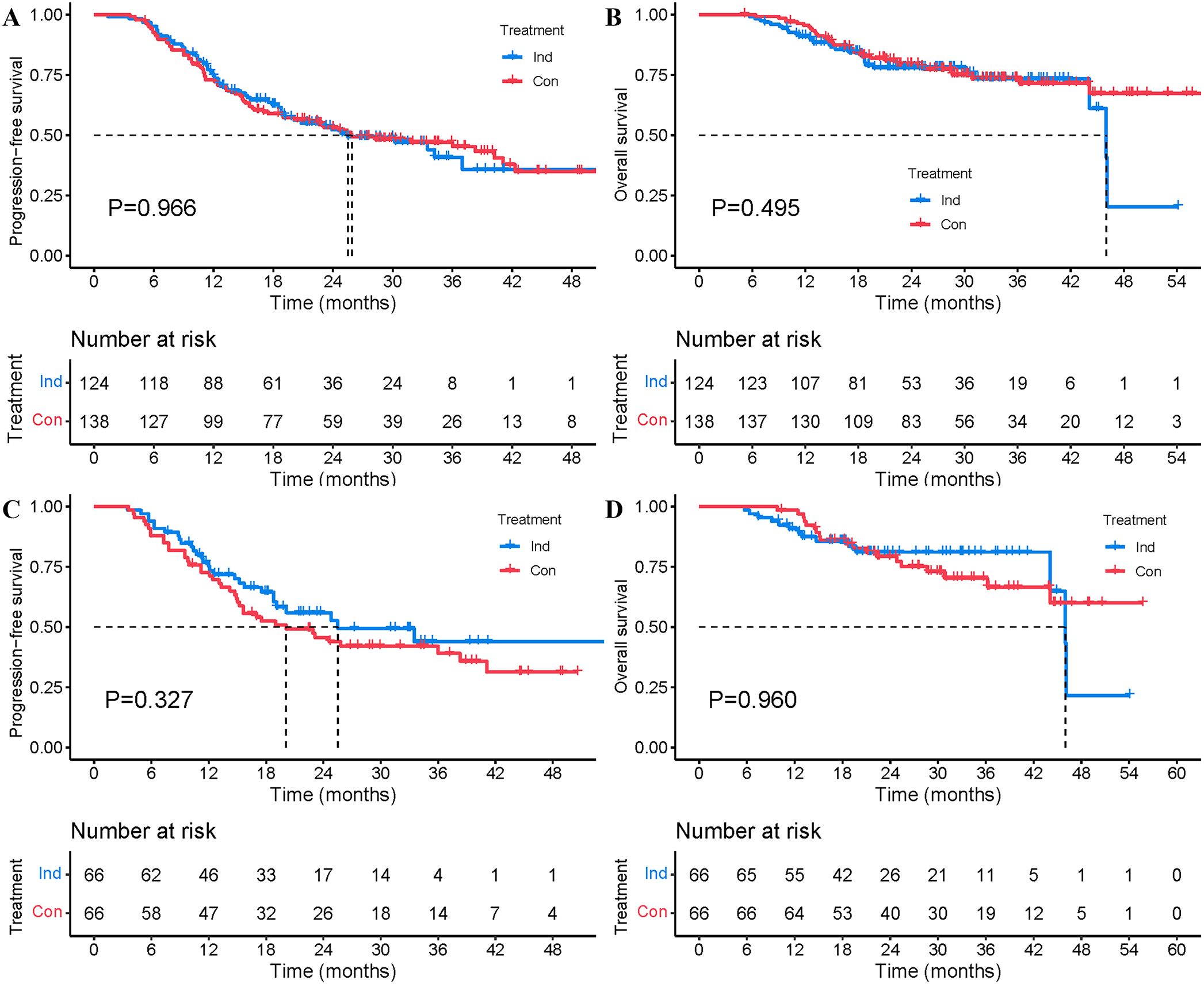
Figure 2. PFS and OS between the Ind and Con groups before and after PSM. (A) PFS from the initiation of treatment before PSM. (B) OS from the initiation of treatment before PSM. (C) PFS from the initiation of treatment after PSM. (D) OS from the initiation of treatment after PSM.
After PSM, patients in the Ind group received significantly fewer cycles of immunotherapy than those in the Con group, with a median of 4 cycles vs. 10 cycles (P<0.001). Survival rates were still not significantly different between the two groups. The median PFS was 25.5 months for the Ind group compared to 20.1 months for the Con group, with a 1-year PFS rate of 76.8% vs. 72.7%, and a 2-year PFS rate of 56.0% vs. 45.6% (P=0.327, Figure 2C). The median OS was 46.0 months for the Ind group, while it was not reached (NR) for the Con group, with a 1-year OS rate of 90.7% vs. 98.5%, and a 2-year OS rate of 81.0% vs. 79.2% (P=0.960, Figure 2D). Patients in the Ind group exhibited a numerically lower incidence of locoregional recurrence (28.8% vs. 40.9%, P=0.144) and distant metastases (18.2% vs. 27.3%, P=0.213) relative to those in the Con group, with no significant differences in the incidence of TRAEs between the two treatment groups (Table 2).
3.4 Exploratory analysis
The ORR and DCR after induction chemoimmunotherapy were 66.1% and 96.0%, respectively. Only 4.0% (5/124) patient developed progression during the induction chemoimmunotherapy phase. Supplementary Figure S1 demonstrates prolonged survival in patients who responded to induction chemoimmunotherapy (CR+PR) compared to those did not (SD+PD) after 1:1 PSM. All clinical characteristics were balanced between groups (Supplementary Table S7). Median PFS was 37.0 months in the CR+PR group vs. 15.7 months in the SD+PD group. The 1- and 2-year PFS rates were 76.9% vs. 64.5% and 56.6% vs. 29.3% (P=0.085, Supplementary Figure S1A). Median OS were all NR, with a 1-year OS rate of 93.5% vs. 80.6% and a 2-year OS rate of 89.5% vs. 62.1% (P=0.024, Supplementary Figure S1B).
The prognostic impact of induction immunotherapy cycles was further investigated. The rationale behind the number of induction immunotherapy cycles chosen was based on patient tolerance (9.7%, n=12), response to treatment (50.8%, n=63), patient refusal (4.0%, n=5) and reference to the preoperative neoadjuvant chemoimmunotherapy modality (35.5%, n=44). According to the median number of induction ICIs cycles, patients were further divided into groups of < 4 and ≥ 4 cycles and matched based on specific criteria including: sex, age, WHO histology, stage, CRT modality, radiation dose, history of smoking, ECOG PS score and response after induction treatment. (Supplementary Table S8). After PSM, patients with < 4 cycles of induction immunotherapy exhibited similar PFS (median NR vs. 30.1 months, 2-year PFS 50.8% vs. 54.4%, P=0.932, Figure 4A) but prolonged OS (median NR vs. 46.0 months, 2-year OS 89.0% vs. 75.5%, P=0.112, Figure 4B) compared to those with ≥ 4 cycles of induction immunotherapy.
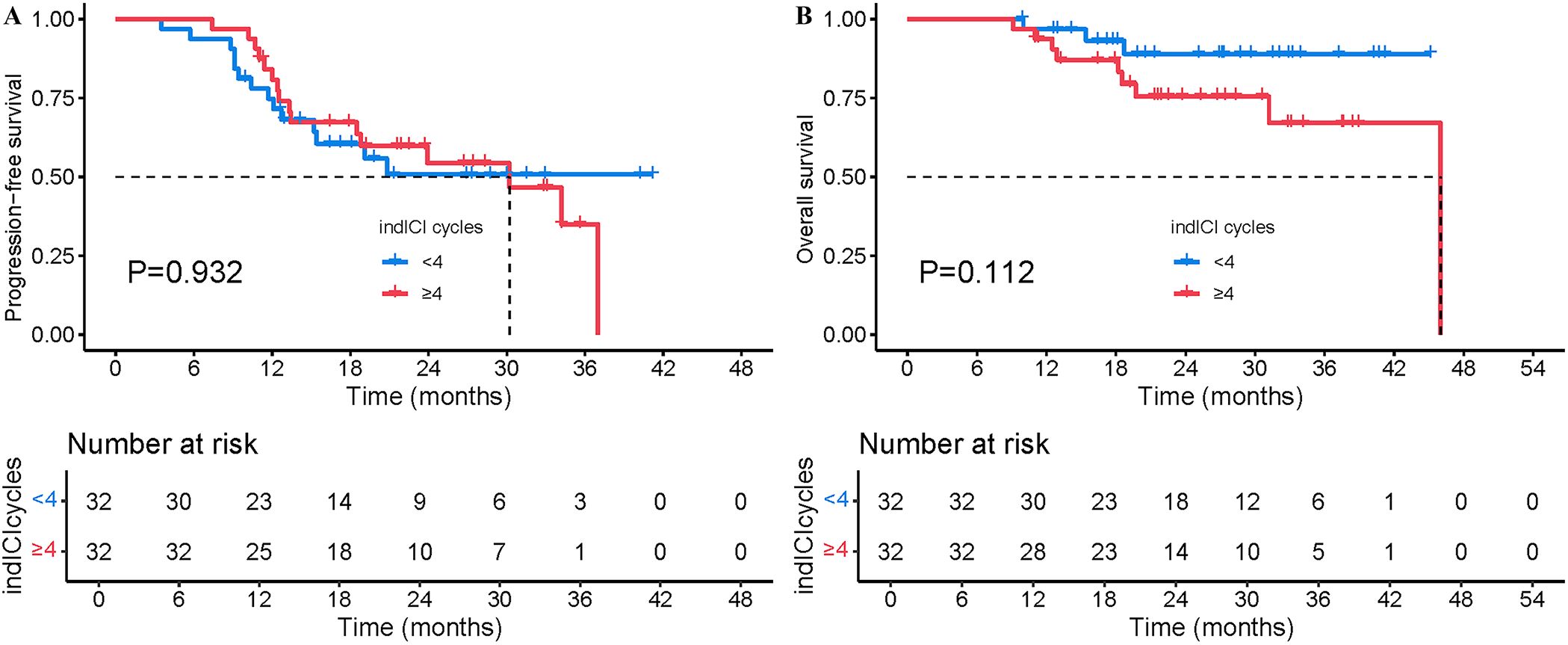
Figure 4. Comparison of PFS and OS between patients who received < 4 cycles of induction immunotherapy and those who received ≥ 4 cycles after PSM. (A) PFS from the initiation of treatment after PSM. (B) OS from the initiation of treatment after PSM.
4 Discussion
Currently, the optimal combination strategy that involves CRT and immunotherapy remains to be fully elucidated. It is unclear whether upfront chemoimmunotherapy prior to CRT could achieve efficacy that is non-inferior to that of consolidation immunotherapy. This study seeks to evaluate the impact of induction chemoimmunotherapy in unresectable stage III NSCLC. To our knowledge, this is the first multicenter study that assesses the role of upfront chemoimmunotherapy before CRT in unresectable stage III NSCLC using real-world data and directly compare it with consolidation immunotherapy.
Although the PACIFIC regimen remains the standard of care for unresectable stage III NSCLC, the significant proportion of patients in the real world who are ineligible for cCRT due to high tumor burden or high risk of pulmonary toxicity, together with the low proportion of patients receiving subsequent consolidation immunotherapy, leading to an increasing recommendation of upfront chemoimmunotherapy before CRT (20, 21). Induction therapy has the theoretical advantages of reducing the target volume to adhere to normal tissue constraints, promoting early intervention for distant micrometastatic disease, and helping to identify the treatment-sensitive population compared to consolidation therapy. Notably, whereas the value of preoperative chemoimmunotherapy in resectable or even potentially resectable NSCLC has been gradually recognized, the role of upfront chemoimmunotherapy before thoracic radiation in unresectable stage III NSCLC has not been extensively explored. At our four centers, induction chemoimmunotherapy is attempted in a proportion of patients with high tumor burden or a strong desire for surgery to shrink the tumor as much as possible. Although all patients who received induction chemoimmunotherapy were advised to continue with consolidation immunotherapy, a significant number of patients declined due to financial burden, concerns about TRAEs, etc., giving us this unique opportunity to explore the value of induction chemoimmunotherapy. The preliminary study found that adding only a median of 4 cycles of immunotherapy before CRT significantly improved PFS in patients with unresectable stage III NSCLC compared with conventional CRT modalities, but this study did not directly compare this treatment regimen with consolidation immunotherapy (22). Interestingly, further PSM analysis in our study indicated that induction chemoimmunotherapy alone may yield outcomes comparable to those achieved with consolidation immunotherapy, with fewer cycles of immunotherapy. The underlying mechanism may be due to the addition of chemotherapy during immunotherapy. Previous studies have shown superior outcomes with chemoimmunotherapy compared to immunotherapy alone, both in advanced NSCLC and in the neoadjuvant phase of early-stage NSCLC (23, 24). In the present study, most patients in the Con group received ICI monotherapy after CRT, while those who received induction immunotherapy all received the combination of immunotherapy and chemotherapy. In addition, a preclinical study suggested that induction immunotherapy is superior to consolidation immunotherapy in reducing distant metastases (25), which may also contribute to this result. Of note, the role of induction chemoimmunotherapy in our study may be underestimated because we excluded patients with disease progression prior to immunotherapy based on the inclusion criteria of the PACIFIC regimen, whereas a significant proportion of patients experience disease progression before consolidation immunotherapy in real-world clinical practice. However, even in this setting, induction chemoimmunotherapy still achieved non-inferior outcomes to consolidation immunotherapy, suggesting the promising outcomes of this new approach.
In addition to efficacy, the safety and feasibility of induction chemoimmunotherapy is also a concern of our study. Only 4.0% of patients who received induction chemoimmunotherapy progressed during the induction immunotherapy phase, and the ORR and DCR after induction immunotherapy were 66.1% and 96.0%, respectively, which is similar to the findings of Wang et al. (76.1% and 86.7%) (26). We further explored the relationship between treatment response and prognosis. Despite various tumor responses to treatment after immunotherapy, such as pseudoprogression and hyperprogression (27, 28), our results demonstrated that tumor shrinkage on imaging after immunotherapy remains an important indicator of improved prognosis. In addition, albeit non-significant, the numerically lower incidence of TRAEs in the Ind group, especially the incidence of pneumonia, which is of greater concern, suggests the safety and feasibility of upfront chemoimmunotherapy before CRT.
The potential theoretical advantages of induction treatment and the remarkable efficacy of preoperative neoadjuvant chemoimmunotherapy have led to the gradual application of induction chemoimmunotherapy in clinical practice. However, the evidence on how many cycles of immunotherapy before CRT are more appropriate is limited. As an exploratory treatment modality, the rationale behind the number of induction immunotherapy cycles chosen is mainly based on the sequential chemoradiotherapy modality to minimize tumor burden, or in reference to preoperative neoadjuvant chemoimmunotherapy cycles. However, even in the surgical setting, the optimal number of cycles of neoadjuvant immunotherapy is controversial. Although 3 cycles of neoadjuvant chemoimmunotherapy appears to be more acceptable, a real-world study found that there was no significant difference in the MPR rate or survival outcomes between 2 cycles and 3–4 cycles of neoadjuvant immunotherapy (29, 30). Conversely, a phase 2 clinical trial demonstrated that 3 cycles of neoadjuvant chemoimmunotherapy archived numerically higher MPR rate (41.4% vs. 26.9%, P=0.260) and pCR rate (24.1% vs. 19.2%, P=0.660) compared with 2 cycles (31). Our result showed that patients with < 4 cycles of induction immunotherapy appeared to have prolonged survival, which is consistent with the findings of Wang et al. (26). They found no difference in ORR between 2 and 4 cycles of induction immunotherapy (60.5% vs. 69.8%, P=0.248), but DCR after 2 cycles was significantly higher than after 4 cycles (97.7% vs. 88.4%, P=0.046). Taken together, early local radical treatment for stage III NSCLC is crucial. Prolonging cycles of induction immunotherapy excessively may not only fail to provide further survival benefits, but may also lead to disease progression and an increased incidence of TRAEs.
The present study has several inherent limitations. Firstly, the retrospective nature of the study limits the extent to which the findings can be generalized. In addition, the study is limited by incomplete data on PD-L1 expression, as this biomarker is not routinely assessed in stage III NSCLC across the four participating centers. Furthermore, the study did not differentiate between various ICIs. Although previous research suggests that there are no significant differences in safety and efficacy profiles among different ICIs or ICI types (32–34), and our study found no significant effect of ICI type on survival outcomes, future investigations should use a uniform ICI and stratify patients based on PD-L1 expression levels to minimize confounding. Finally, the study’s conclusions may be somewhat limited by the relatively modest patient sample size. Despite these limitations, this is the first multicenter study to evaluate the role of upfront chemoimmunotherapy before CRT in unresectable stage III NSCLC using real-world data, and we believe this study may shed some light on clinical practice or provide a treatment option for patients.
5 Conclusions
Upfront chemoimmunotherapy before CRT appears to be feasible and safe, and may achieve comparable outcomes to consolidation immunotherapy with fewer cycles of immunotherapy.
Data availability statement
The raw data supporting the conclusions of this article will be made available by the authors, without undue reservation.
Ethics statement
The studies involving humans were approved by The institutional review board of Tianjin Medical University Cancer Institute and Hospital (No. bc2022212). The studies were conducted in accordance with the local legislation and institutional requirements. Written informed consent for participation was not required from the participants or the participants’ legal guardians/next of kin in accordance with the national legislation and institutional requirements.
Author contributions
SG: Conceptualization, Data curation, Writing – original draft. YW: Data curation, Writing – original draft. QL: Data curation, Writing – original draft. MY: Formal Analysis, Methodology, Writing – review & editing. KR: Investigation, Writing – review & editing. JW: Project administration, Supervision, Writing – review & editing. NB: Project administration, Supervision, Writing – review & editing. LZ: Conceptualization, Project administration, Supervision, Writing – review & editing.
Funding
The author(s) declare that financial support was received for the research and/or publication of this article. This research was funded by the Tianjin Key Medical Discipline (Specialty) Construction Project (TJYXZDXK-009A).
Conflict of interest
The authors declare that the research was conducted in the absence of any commercial or financial relationships that could be construed as a potential conflict of interest.
Generative AI statement
The author(s) declare that no Generative AI was used in the creation of this manuscript.
Publisher’s note
All claims expressed in this article are solely those of the authors and do not necessarily represent those of their affiliated organizations, or those of the publisher, the editors and the reviewers. Any product that may be evaluated in this article, or claim that may be made by its manufacturer, is not guaranteed or endorsed by the publisher.
Supplementary material
The Supplementary Material for this article can be found online at: https://www.frontiersin.org/articles/10.3389/fimmu.2025.1591134/full#supplementary-material
References
1. Antonia SJ, Villegas A, Daniel D, Vicente D, Murakami S, Hui R, et al. Durvalumab after chemoradiotherapy in stage III non-small-cell lung cancer. New Engl J Med. (2017) 377:1919–29. doi: 10.1056/NEJMoa1709937
2. Spigel DR, Faivre-Finn C, Gray JE, Vicente D, Planchard D, Paz-Ares L, et al. Five-year survival outcomes from the PACIFIC trial: durvalumab after chemoradiotherapy in stage III non-small-cell lung cancer. J Clin Onol. (2022) 40:1301–11. doi: 10.1200/JCO.21.01308
3. Cotarla I, Boron ML, Cullen SL, Spinner DS, Faulkner EC, Carroll MC, et al. Treatment decision drivers in stage III non–small-cell lung cancer: outcomes of a web-based survey of oncologists in the United States. JCO Oncol Pract. (2020) 16:e1232–42. doi: 10.1200/JOP.19.00781
4. Xing L, Yu J, Zhao R, Yang W, Guo Y, Li J, et al. 125P Real-world treatment patterns in stage III NSCLC patients: Interim results of a prospective, multicenter, noninterventional study (MOOREA). J Thorac Oncol. (2023) 18:S111–2. doi: 10.1016/S1556-0864(23)00380-5
5. Zhou Q, Chen M, Jiang O, Pan Y, Hu D, Lin Q, et al. Sugemalimab versus placebo after concurrent or sequential chemoradiotherapy in patients with locally advanced, unresectable, stage III non-small-cell lung cancer in China (GEMSTONE-301): interim results of a randomised, double-blind, multicentre, phase 3 trial. Lancet Oncol. (2022) 23:209–19. doi: 10.1016/S1470-2045(21)00630-6
6. Bruni A, Scotti V, Borghetti P, Vagge S, Cozzi S, D’Angelo E, et al. A real-world, multicenter, observational retrospective study of durvalumab after concomitant or sequential chemoradiation for unresectable stage III non-small cell lung cancer. Front Oncol. (2021) 11:744956. doi: 10.3389/fonc.2021.744956
7. Forde PM, Spicer J, Lu S, Provencio M, Mitsudomi T, Awad MM, et al. Neoadjuvant nivolumab plus chemotherapy in resectable lung cancer. New Engl J Med. (2022) 386:1973–85. doi: 10.1056/NEJMoa2202170
8. Felip E, Altorki N, Zhou C, Csőszi T, Vynnychenko I, Goloborodko O, et al. Adjuvant atezolizumab after adjuvant chemotherapy in resected stage IB-IIIA non-smallcell lung cancer (IMpower010): a randomised, multicentre, open-label, phase 3 trial. Lancet. (2021) 398:1344–57. doi: 10.1016/S0140-6736(21)02098-5
9. O’Brien M, Paz-Ares L, Marreaud S, Dafni U, Oselin K, Havel L, et al. Pembrolizumab versus placebo as adjuvant therapy for completely resected stage IB-IIIA non-small-cell lung cancer (PEARLS/KEYNOTE-091): an interim analysis of a randomised, triple-blind, phase 3 trial. Lancet Oncol. (2022) 23:1274–86. doi: 10.1016/S1470-2045(22)00518-6
10. Ross HJ, Kozono DE, Urbanic JJ, Williams TM, DuFrane C, Bara I, et al. AFT-16: Phase II trial of neoadjuvant and adjuvant atezolizumab and chemoradiation (CRT) for stage III non-small cell lung cancer (NSCLC). J Clin Oncol. (2021) 39:8513–3. doi: 10.1200/JCO.2021.39.15_suppl.8513
11. Provencio M, Campos B, Guirado M, Vilà L, Campelo M, Dorta M, et al. OA12.05 APOLO: phase II trial of induction chemo-immunotherapy plus chemoradiotherapy and maintenance immunotherapy in stage III NSCLC. J Thorac Oncol. (2024) 19:S37. doi: 10.1016/j.jtho.2024.09.067
12. Yang Y, Wang J, Zhang T, Zhou Z, Wang Y, Jiang Y, et al. Efficacy and safety of definitive chemoradiotherapy with or without induction immune checkpoint inhibitors in patients with stage III non-small cell lung cancer. Front Immunol. (2023) 14:1281888. doi: 10.3389/fimmu.2023.1281888
13. Travis WD, Brambilla E, Nicholson AG, Yatabe Y, Austin JHM, Beasley MB, et al. The 2015 World Health Organization Classification of Lung Tumors: impact of genetic, clinical and radiologic advances since the 2004 classification. J Thorac Oncol. (2015) 10:1243–60. doi: 10.1097/JTO.0000000000000630
14. Detterbeck FC, Boffa DJ, Kim AW, and Tanoue LT. The eighth edition lung cancer stage classification. Chest. (2017) 151:193–203. doi: 10.1016/j.chest.2016.10.010
15. Zhou C, Chen G, Huang Y, Zhou J, Lin L, Feng J, et al. Camrelizumab plus carboplatin and pemetrexed versus chemotherapy alone in chemotherapy-naive patients with advanced non-squamous non-small-cell lung cancer (CameL): a randomised, open-label, multicentre, phase 3 trial. Lancet Resp Med. (2021) 9:305–14. doi: 10.1016/s2213-2600(20)30365-9
16. Yang Y, Wang Z, Fang J, Yu Q, Han B, Cang S, et al. Efficacy and Safety of Sintilimab Plus Pemetrexed and Platinum as First-Line Treatment for Locally Advanced or Metastatic Nonsquamous NSCLC: a Randomized, Double-Blind, Phase 3 Study (Oncology pRogram by InnovENT anti-PD-1-11). J Thorac Oncol. (2020) 15:1636–46. doi: 10.1016/j.jtho.2020.07.014
17. Wang J, Lu S, Yu X, Hu Y, Sun Y, Wang Z, et al. Tislelizumab plus chemotherapy vs chemotherapy alone as first-line treatment for advanced squamous non-small-cell lung cancer: A phase 3 randomized clinical trial. JAMA Oncol. (2021) 7:709–17. doi: 10.1001/jamaoncol.2021.0366
18. Lu S, Wu L, Zhang W, Zhang P, Wang W, Fang W, et al. Perioperative toripalimab + platinum-doublet chemotherapy vs chemotherapy in resectable stage II/III non-small cell lung cancer (NSCLC): Interim event-free survival (EFS) analysis of the phase III Neotorch study. J Clin Oncol. (2023) 41:425126–6. doi: 10.1200/JCO.2023.41.36_suppl.425126
19. Wakelee H, Liberman M, Kato T, Tsuboi M, Lee SH, Gao S, et al. Perioperative pembrolizumab for early-stage non-small-cell lung cancer. New Engl J Med. (2023) 389:491–503. doi: 10.1056/NEJMoa2302983
20. Lang P and Palma D. Too big to fail: miracle drugs or false hope? Int J Radiat Oncol. (2021) 110:264. doi: 10.1016/j.ijrobp.2020.10.013
21. Chang JY. When constrained by constraints: thinking outside of the box in both technology and biology. Int J Radiat Oncol. (2021) 110:266–7. doi: 10.1016/j.ijrobp.2020.10.014
22. Guan S, Zhang S, Ren K, Li X, Li X, and Zhao L. Induction chemoimmunotherapy may improve outcomes of chemoradiotherapy in patients with unresectable stage III NSCLC. Front Immunol. (2023) 14:1289207. doi: 10.3389/fimmu.2023.1289207
23. Di Federico A, De Giglio A, Gelsomino F, Sperandi F, Melotti B, Ardizzoni A, et al. Predictors of survival to immunotherapy and chemoimmunotherapy in non-small cell lung cancer: A meta-analysis. Jnci-J Natl Cancer I. (2023) 115:29–42. doi: 10.1093/jnci/djac205
24. Jiang J, Wang Y, Gao Y, Sugimura H, Minervini F, Uchino J, et al. Neoadjuvant immunotherapy or chemoimmunotherapy in non-small cell lung cancer: a systematic review and meta-analysis. Transl Lung Cancer R. (2022) 11:277–94. doi: 10.21037/tlcr-22-75
25. Liu J, Blake SJ, Yong MC, Harjunpää H, Ngiow SF, Takeda K, et al. Improved efficacy of neoadjuvant compared to adjuvant immunotherapy to eradicate metastatic disease. Cancer Discov. (2016) 6:1382–99. doi: 10.1158/2159-8290.CD-16-0577
26. Wang Y, Zhang T, Wang J, Zhou Z, Liu W, Xiao Z, et al. Induction immune checkpoint inhibitors and chemotherapy before definitive chemoradiation therapy for patients with bulky unresectable stage III non-small-cell lung cancer. Int J Radiat Oncol. (2023) 116:590–600. doi: 10.1016/j.ijrobp.2022.12.042
27. Nishino M. Immune-related response evaluations during immune-checkpoint inhibitor therapy: establishing a “common language” for the new arena of cancer treatment. J Immunother Cancer. (2016) 4:30. doi: 10.1186/s40425-016-0134-0
28. Kim JY, Lee KH, Kang J, Borcoman E, Saada-Bouzid E, Kronbichler A, et al. Hyperprogressive disease during anti-PD-1 (PDCD1)/PD-L1 (CD274) therapy: A systematic review and meta-analysis. Cancers (Basel). (2019) 11:1699. doi: 10.3390/cancers11111699
29. Liang W, Cai K, Cao Q, Chen C, Chen H, Chen J, et al. International expert consensus on immunotherapy for early-stage non-small cell lung cancer. Transl Lung Cancer R. (2022) 11:1742–62. doi: 10.21037/tlcr-22-617
30. Zhang B, Guo X, Jia R, Wang Z, Wu J, Chen X, et al. Neoadjuvant chemoimmunotherapy cycle number selection for non-small cell lung cancer and clinical outcomes: a real-world analysis. Front Oncol. (2023) 13:1200625. doi: 10.3389/fonc.2023.1200625
31. Qiu F, Fan J, Shao M, Yao J, Zhao L, Zhu L, et al. Two cycles versus three cycles of neoadjuvant sintilimab plus platinum-doublet chemotherapy in patients with resectable non-small-cell lung cancer (neoSCORE): A randomized, single center, two-arm phase II trial. J Clin Oncol. (2022) 40:8500. doi: 10.1200/JCO.2022.40.16_suppl.8500
32. Miao K, Zhang X, Wang H, Si X, Ni J, Zhong W, et al. Real-world data of different immune checkpoint inhibitors for non-small cell lung cancer in China. Front Oncol. (2022) 12:859938. doi: 10.3389/fonc.2022.859938
33. Pillai RN, Behera M, Owonikoko TK, Kamphorst AO, Pakkala S, Belani CP, et al. Comparison of the toxicity profile of PD-1 versus PD-L1 inhibitors in non-small cell lung cancer: A systematic analysis of the literature. CANCER-AM Cancer Soc. (2018) 124:271–7. doi: 10.1002/cncr.31043
Keywords: chemoradiotherapy, consolidation immunotherapy, induction chemoimmunotherapy, non-small cell lung cancer, prognosis
Citation: Guan S, Wang Y, Liu Q, Yan M, Ren K, Wang J, Bi N and Zhao L (2025) Induction chemoimmunotherapy may achieve non-inferior outcomes to consolidation immunotherapy in patients with unresectable stage III NSCLC: a real-world multicenter retrospective study. Front. Immunol. 16:1591134. doi: 10.3389/fimmu.2025.1591134
Received: 10 March 2025; Accepted: 26 May 2025;
Published: 12 June 2025.
Edited by:
Mohamed Rahouma, NewYork-Presbyterian, United StatesCopyright © 2025 Guan, Wang, Liu, Yan, Ren, Wang, Bi and Zhao. This is an open-access article distributed under the terms of the Creative Commons Attribution License (CC BY). The use, distribution or reproduction in other forums is permitted, provided the original author(s) and the copyright owner(s) are credited and that the original publication in this journal is cited, in accordance with accepted academic practice. No use, distribution or reproduction is permitted which does not comply with these terms.
*Correspondence: Jun Wang, d2FuZ2p1bjA4MThAaGVibXUuZWR1LmNu; Nan Bi, YmluYW5fZW1haWxAMTYzLmNvbQ==; Lujun Zhao, emhhb2x1anVuQHRqbXVjaC5jb20=
†These authors have contributed equally to this work and share first authorship
 Song Guan
Song Guan Yu Wang
Yu Wang Qing Liu
Qing Liu Meng Yan
Meng Yan Kai Ren1
Kai Ren1 Jun Wang
Jun Wang Nan Bi
Nan Bi Lujun Zhao
Lujun Zhao